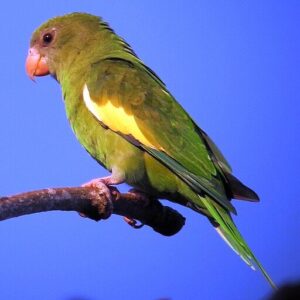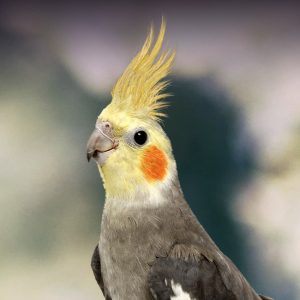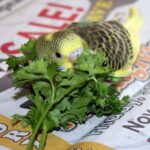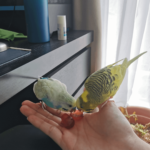American Budgies are smaller, with a sleeker appearance, while English Budgies are larger and puffier. The English variety is often favored for shows due to its size and plumage.
Budgerigars, commonly known as budgies, are a popular pet bird with two distinct types: the American and the English Budgie. These charming birds vary in size, appearance, and temperament, making them suitable for various owners. The American Budgie, also referred to as the wild-type or parakeet, is the smaller of the two, beloved for its playful and social nature.
On the flip side, the English Budgie, bred for show and companionship, boasts a more substantial build and a fuller coat of feathers, giving it a regal look compared to its American counterpart. Both varieties share a similar spectrum of vibrant colors and the ability to mimic human speech, making them delightful companions for bird enthusiasts. Selecting between the two depends on personal preference for size, appearance, and activity level.

Credit: lafeber.com
The Origins Of Budgerigars
Bustling with personality and vibrant colors, the Budgerigar, also known as the Budgie, is a beloved pet around the world. These charming birds hail from the sunbaked lands of Australia, where they flutter in the wild in massive, noisy flocks. Their journey from the Australian outback to our homes is a story of beauty, adaptation, and worldwide affection. The origins of the Budgie are as intriguing as the birds themselves.
From Australian Wilds To Global Hearts
The wild ancestor of the Budgie is a small, nimble parrot with green plumage, adept at surviving in the harsh Australian environment. Indigenous Australians first admired these birds for their vibrant energy and sociable nature. European settlers noticed them in the 1800s and soon after, Budgies began their global journey.
- Budgies were first captured and exported to Europe.
- Their colors and songs won hearts far from their native land.
- Breeding programs started to enhance their colors and features.
Development Of The American And English Varieties
Two distinct types of Budgies emerged: the American and the English Budgie. The American Budgie, often called the “Wild-type”, stayed true to its Australian roots in size and shape. It is small, sleek, and mimics its ancestors’ agility and wild spirit.
In contrast, the English Budgie, developed in Britain, became larger with more pronounced features and a puffier appearance, often described as the “Show-type”. Breeders focused on creating a bird with a variety of colors and a calmer demeanor.
| Feature | American Budgie | English Budgie |
|---|---|---|
| Size | Smaller | Larger |
| Feathers | Smoother | Fluffier |
| Temperament | Active | Gentler |
| Origin | Australia | Britain |
Today’s Budgie lovers can choose between these two delightful varieties. Both share the same playful character and ability to bond with their owners. Each brings a slice of Australian sunshine to homes around the globe.
Physical Characteristics
Dive into the charming world of the American and English Budgie. These delightful birds boast distinct features. Let’s flutter into their physical traits. This knowledge helps select the perfect feathered friend.
American Budgie: Size, Color, And Feature Descriptions
The American Budgie, also known as the Parakeet, is a vibrant fluff of joy. Known for their slender build and graceful profile.
- Size: Typically around 7 inches from beak to tail.
- Color: A rainbow palette. From classic greens and yellows to rarer blues and whites.
- Features: Svelte with streamlined bodies and sleek feathers. Their expressive faces feature circular cheek spots and a delicate scallop-pattern.
English Budgie: Distinctive Traits And Show Standards
The English Budgie’s regal stance steals the show. Their bold look sets them apart from their American cousins.
| Trait | Description |
|---|---|
| Size | Heavier and chunkier, often reaching up to 9-10 inches in length. |
| Features | Dense plumage, full cheeks, and a broad head. Show birds exhibit a certain ‘puff’ around the neck known as a mane. |
| Show Standards | Deep coloration, perfect posture, and manicured feathers. Judges seek out that distinctive English Budgie ‘look’. |
Behavioral Traits And Temperament
Understanding the behavioral traits and temperament of budgies is key to a happy relationship with these feathered companions. American and English Budgies are delightful pets with distinct personalities. Let’s delve into what sets them apart in the social and behavioral spectrum.
Social Dynamics Of American Budgies
American Budgies, also known as parakeets, are among the most social birds in the Budgie family. Here’s what they offer:
- Playful Nature: They love interactive toys and puzzles.
- Chirpy and Vocal: American Budgies will fill your home with joyful chirps.
- Enjoys Companionship: They thrive with either human interaction or another Budgie pal.
Their social behavior is characterized by an eagerness to engage with their owners and environment.
English Budgies Personality: A Comparison
English Budgies present a more serene personality. Below are traits you may observe:
| Personality Trait | Description |
|---|---|
| Gentler Demeanor | English Budgies are less boisterous and display calmer behavior. |
| Affectionate Companions | They enjoy close contact and may be more inclined to cuddle. |
| Elegant Interaction | With a noble bearing, interactions are often more refined. |
Despite their gentle nature, they still possess a playful side and require social interaction.
Health And Lifespan
Bird enthusiasts often debate the merits of the American Budgie versus the English Budgie. While both can bring joy to pet owners, understanding their health and lifespan is crucial. Proper care can lead to a happy, healthy life for these feathered friends.
Typical Health Issues In Both Varieties
American and English Budgies may encounter similar health challenges. Common issues include:
- Respiratory Infections: Symptoms like sneezing and nasal discharge.
- Scaly Face Mites: Cause crusty beaks, vents, and eyelids.
- Psittacosis: Also known as parrot fever, it’s a bacterial infection.
Regular check-ups with a vet are vital. They can spot and treat these problems early.
Comparing Lifespan: American Vs English Budgie
The lifespan of a budgie can vary based on care, diet, and genetics. Here is a comparison:
| Type of Budgie | Average Lifespan |
|---|---|
| American Budgie | 5-10 years |
| English Budgie | 4-8 years |
The American Budgie generally lives a bit longer. A balanced diet, exercise, and love contribute to their longevity. The English Budgie’s larger size may factor into their slightly shorter lifespan.
Care Requirements
Caring for a budgie requires understanding their specific needs. American Budgies and English Budgies have similar care requirements. Yet, some differences are important to note. Proper housing and specific attention cater to their health and happiness. Let’s dive into what each of these charming birds needs to thrive.
Housing Needs For American Budgie
American Budgies, known for their active nature, need spacious cages. A large cage allows for flight and exercise. Here are key points for housing:
- Size: Minimum 18 x 18 x 24 inches for one budgie. Larger is always better.
- Bar Spacing: No more than 1/2 inch to prevent escapes or injury.
- Perches: Provide varying diameters for foot health. Avoid dowel-only setups.
- Toys: Stimulate their mind with chewable and interactive toys.
Remember to place the cage in a social area away from drafts and direct sunlight.
Special Care Considerations For English Budgie
English Budgies are larger and have fluffier feathers than their American counterparts. Their care includes:
| Aspect | Special Consideration |
|---|---|
| Temperature | Keep them in a warm area to prevent colds, avoid temperature fluctuations. |
| Grooming | Regularly check and trim overgrown nails and beaks as needed. |
| Cleaning | Maintain clean feathers, especially around the vent area. |
| Space | They require extra space due to their size; a larger cage is essential. |
Extra grooming care keeps English Budgies healthy. Their dense feathers can gather more dirt and moisture, which, if ignored, can lead to skin problems. Ensure perches and toys are sturdy enough to hold their additional weight.

Credit: deadline.com
Breeding And Genetic Differences
The world of budgerigars is vibrant and diverse, with American Budgies and English Budgies at the forefront. Understanding the breeding and genetic differences between these two birds is crucial for enthusiasts and breeders alike. Let’s delve into the intricacies that set them apart.
Selective Breeding Practices For Desirable Traits
Selective breeding shapes budgie varieties. Breeding selects traits like color, size, and temperament. American and English Budgies differ greatly due to these practices.
- Smaller, sleeker American Budgies arose from breeding for agility and pet-quality characteristics.
- English Budgies, often larger and with fuller plumage, result from a focus on show-worthy attributes.
Each variety’s distinct pedigree reflects generations of careful selection to reinforce specific traits that breeders and enthusiasts cherish.
Impact On Health And Vitality
While selective breeding can enhance specific traits, it also impacts health and vitality. Understanding these genetic nuances is crucial for maintaining thriving budgie populations.
| Variety | Health Concerns |
|---|---|
| American Budgie | Potentially longer lifespan, fewer genetic issues due to wider gene pool. |
| English Budgie | Prone to certain ailments, such as respiratory issues, due to intensive breeding. |
Ensuring genetic diversity and monitoring breeding practices supports healthier budgie generations. Breeders must weigh the benefits of certain traits against the risks to a budgie’s overall vitality.
Popular As Pets
Budgerigars, or budgies, grace homes worldwide with their vibrant colors and cheerful songs. Native to Australia, these birds have evolved into two main types: the American Budgie and the English Budgie. Each offers unique traits that make them delightful companions. Families and solo owners often ponder which budgie variety to invite into their homes. Discover why these feathered friends have become popular pets.
Why American Budgies Win Hearts
American Budgies, often known as parakeets in the United States, possess a charm that easily captures hearts. Their small size and energetic personality make them ideal for those with limited space.
- Active and playful
- Easy to train with patience
- Can learn to mimic words and sounds
These birds offer endless entertainment, making them a top pick for pet lovers. Owners find their care straightforward, thanks to the budgies’ adaptability and robust nature.
The Distinct Appeal Of English Budgies
English Budgies bring a striking allure to the bird lover’s collection. Recognized by their larger build and lush plumage, they often find favor with enthusiasts and those seeking a more docile pet.
| Feature | English Budgie |
|---|---|
| Size | Bigger and robust |
| Temperament | Gentle and less active |
| Plumage | More pronounced |
Though they may be less inclined to frolic than their American counterparts, English Budgies are known for their affable nature. They make great pets for those seeking a calmer bird. Their dignified appearance is often preferred by show bird enthusiasts.

Credit: lafeber.com
In The Bird Show Arena
Bird enthusiasts gather to see the beauty and charm of Budgies in competitive shows. In these events, two types of Budgies often steal the spotlight: the American Budgie and the English Budgie. Known for their distinctive features and personalities, both compete for admiration and awards.
English Budgie: The Show Bird Of Choice
The English Budgie, with its robust body and calm demeanor, is a favorite among judges. Judges look for several key traits:
- Broad chest and shoulders for a regal posture.
- Puffy head feathers which give a full and rounded appearance.
- Rich, vibrant colors and clear patterns in their plumage.
- Stable and composed behavior fitting for a show bird.
These features are scored during competitions, and English Budgies often outshine their American counterparts.
American Budgie In Competitive Bird Shows
The American Budgie, known for being playful and active, faces stiff competition in shows. They are judged on:
- Sleek and slender body shape which differs from the English variant.
- Bright and even feather coloration, a key characteristic judges observe.
- Ability to move gracefully and interact within the show environment.
While the American Budgie may not be the traditional show bird, it brings uniqueness to the arena.
| Feature | English Budgie | American Budgie |
|---|---|---|
| Size | Larger and Fuller | Smaller and Sleeker |
| Temperament | Calm and Composed | Lively and Playful |
| Activity Level | Lower, more refined | Higher, more energetic |
Choosing Your Feathered Companion
When deciding between an American Budgie and an English Budgie, understanding the differences helps in making a perfect choice. American Budgies, also known as parakeets, are petite, agile, and great for first-time bird owners. English Budgies are larger, fluffier and often chosen for shows. Each bird offers unique qualities that could match your lifestyle and commitment desires.
Considering Lifestyle Fit And Time Commitment
American Budgies are known for their playful nature and may require less grooming due to their shorter feather coat. These energetic birds fit well with active families. They love interaction and thrive with daily playtime.
English Budgies, with their calm demeanor, often require more attention to grooming. They can be a joy for individuals or families who prefer a less active pet. English Budgies need quality time and gentle handling to maintain their social nature.
Selecting between the two depends on your daily routine and how much time you’re willing to dedicate. Carefully assess:
- Your availability for daily interaction
- Grooming and maintenance requirements
- Suitability of the bird’s energy level with your lifestyle
Finding Reputable Breeders And Adoption Options
Purchasing or adopting a feathered companion requires careful consideration. Reputable breeders ensure the health and well-being of the birds. They are knowledgeable about the breed and can offer support post-adoption. Seek breeders with positive reviews and transparent practices.
Adoption is another loving option. Many birds need a second chance at a forever home. Contact local aviaries or bird rescue organizations to learn about adoption processes. These centers often provide full histories and can match you with a budgie suited to your lifestyle.
Researching breeders or adoption centers includes:
| Aspect | Details to Consider |
|---|---|
| Health Certifications | Proof of healthy breeding practices |
| Experience | Years working with budgies |
| Aftercare Support | Guidance available after purchase/adoption |
| Reviews | Positive testimonials from previous buyers/adopters |
With these considerations in mind, you can make an educated decision to find a feathered friend that truly fits your life.
Myths And Misconceptions
Among bird enthusiasts, tales and myths surrounding American Budgies and English Budgies often flutter about, blurring lines between fact and fiction. It’s easy to fall prey to these misconceptions, but let’s set the record straight. This section will unveil the truth behind the vibrant world of Budgie breeds, separating myths from facts, and celebrating the distinctiveness of each variety.
Debunking Common Myths About Budgie Varieties
Myth 1: “English Budgies live longer than American Budgies.” This is not true. Both varieties have similar lifespans when given proper care. Lifespan depends more on diet, environment, and genetics, not type.
Myth 2: “American Budgies are friendlier.” Friendliness is not breed-specific. It varies with each bird’s individual personality and how much it is handled.
Myth 3: “English Budgies can’t be kept in warm climates.” While English Budgies originate from a cooler climate, they adapt well to various environments with appropriate care.
Myth 4: “Smaller American Budgies are not as robust.” Size does not determine health. Proper care ensures both breeds can be equally hearty.
Appreciating Each Breed’s Unique Qualities
Let’s embrace the diversity between these feathery companions. A list of distinct qualities for both breeds is presented:
- English Budgie: Larger, with fluffier head feathers and a more pronounced ‘mop-top’ appearance.
- American Budgie: Smaller and quicker, often with more vibrant color patterns.
Both types bring their own charm to any home. By acknowledging these qualities, we highlight what makes each bird special beyond outdated myths. Enjoy your Budgie for its unique personality and beauty, which shines through regardless of its origin.
Conclusion
Deciding between an American and an English Budgie comes down to your preferences. Both birds offer distinct charm and companionship. Consider care requirements, personality, and appearance when making your choice. Whichever you choose, you’re in for a delightful feathered friend.
Embrace the journey into budgie ownership!
Ryan Everhart is a passionate bird enthusiast and blogger, primarily writing on his website, Avian Whispers. His journey into the world of bird blogging began with a deep interest in parrots, a species that captivated his attention for their intelligence and social behavior. Over time, his content expanded to cover a broader range of bird species, offering insights into bird behavior, care, habitats, and conservation.
Ryan is dedicated to educating his audience, which includes both new bird owners and seasoned enthusiasts. His writing is filled with personal experiences, expert knowledge, and practical advice on bird care. Through Avian Whispers, he aims to foster a deeper appreciation for birds, emphasizing their role in nature and the joys of having them as pets.
Starting with articles focused on parrots, Ryan’s work now encompasses a diverse range of topics such as feeding, training, habitat enrichment, and bird health. His love for birds extends beyond parrots, diving into various avian species. His informative and heartfelt writing reflects his commitment to the well-being of birds and the desire to help others connect with these creatures.
As a growing voice in the bird blogging community, Ryan strives to provide a platform where bird lovers can learn, share experiences, and connect over a shared passion for avian life. His blogs are not only educational but also serve as a reminder of the importance of protecting and nurturing the bond between humans and birds.




